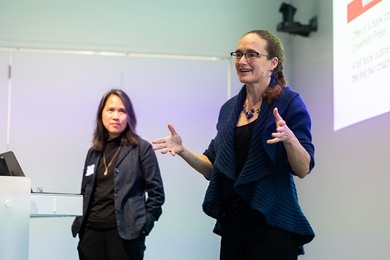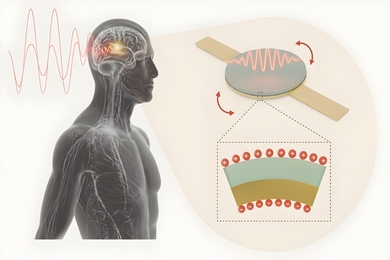Many people carefully store their teaching notes, however illegible or useless, for decades before deciding that papers left untouched for so long should be pitched. Sometimes it's too unbearable to discard anything and the cleaning task falls to the next generation. This was the case with the papers of the late Professor Emeritus Albert Dietz, whose son has donated the building engineer's class notes--some dating from the 1920s--to MIT.
"As far as we can figure out, my father almost never threw out anything," wrote Henry Dietz, son of the late faculty member in the Department of Civil and Environmental Engineering and the Department of Architecture. Albert Dietz, who held three MIT degrees--S.B. 1932, S.M. 1936 and Sc.D. 1941--died in 1998.
Henry Dietz turned over the papers to the Department of Civil and Environmental Engineering, which will give them to the MIT Museum after examining them.
Carefully typed and stored in notebooks, illustrated with exquisite pen-and-ink drawings and indexed by topic, a set of four fat notebooks stood on Albert Dietz's desk throughout his long professional career and were frequently consulted, judging by the dog-eared index tabs. The volumes form a detailed historical account of early 20th-century construction and management processes. They are also a personal tribute to Dietz's dedication to his field, and a showcase for his considerable drawing and calligraphic skills.
The notebooks include material from other faculty members' classes as well as Dietz's. Weekly notes for Professor Ross Tucker's building construction class for Oct. 27, 1929 cover excavation and removal of dirt. "A team is defined as two horses and the driver," who cost $1.50 per hour for an eight-hour day. "A good team on a good road will move about 2.5 miles per hour. Since the team cannot be worked steadily for eight hours," 2 mph, or roughly 10,000 ft, "is a conservative estimate."
After the site is plowed, a drag scraper removes the topsoil, the notes explain. "One man drives the horses while the other manipulates the scraper which is merely a large scoop with a handle on each side for him to use in guiding it. The rated capacity of a drag scraper is 5 cu. ft. but the actual load it will move is 4 cu. ft. due to loss on the way."
A table calculates how much soil the average man will loosen and remove with a pick and shovel, depending on the type of soil, whether it is wet or dry, and whether it is plowed and loosened. In what looks like a classic arithmetic problem, six men work at loading one cart at one time with medium-dry soil. "If each man loads one cu yd per hour and the cart holds two cu yds, then six men can load it in 20 minutes, according to the notes. If the dump is 1,500 feet away (making a round trip of 3,000 feet) and the horse team moves 10,000 feet per hour, it will take 20 minutes for a round trip. Add 20 minutes to load the cart, and it takes 40 minutes to load and haul 2 cubic yds.
Tucker's class on "Job Management" (17.50) emphasizes the need for character, integrity, honesty and fairness. One section tackles the problem of alcohol, whether it's drunken workers or gifts of liquor proffered by contractors currying favor. Dating from March 1932, the notes dutifully record, "As long as Prohibition is the law of the land, it should be observed, whether the man personally believes in it or not. Business ethics say no to the use of alcohol."
Two volumes from 1957 describe the architectural evolution, engineering analysis and structural design of the Monsanto House of the Future, which used plastics in many innovative ways. Step-by-step design, construction and assembly of the plastics pavilion of the American exhibition in Moscow in 1959 are detailed in three well-illustrated volumes by Dietz and Frank Heger (S.B. 1948, S.M. 1949, Sc.D. 1962), one of the three MIT founders of Simpson Gumpertz Heger, a prominent engineering consulting firm based in Arlington. The rounded mushroom-like plastic parts lined up before construction in Moscow look like a flying saucer invasion.
A version of this article appeared in MIT Tech Talk on September 26, 2001.







